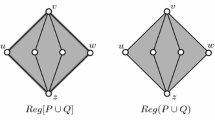Abstract
Reported work on virtual coordinate assignment (VCA) schemes are iterative-based techniques which rely upon geometric projection (i.e., projecting on circle) or embedding of network topology to low-dimensional Euclidean space (like graph embedding, multidimensional scaling). The performance of existing VCA techniques is constrained by topological situations such as low density or having voids/holes, where greedy forwarding suffers due to local minima when no neighbor is found closer to the destination or low-quality routes comprised of long distance hops. Another drawback of existing VCA techniques is the requirement of thousand iterations for usable coordinate convergence. In order to overcome these drawbacks, we propose a novel virtual coordinate construction technique using graph-theoretic dominating sets. Dominating set (DS) of G is a subset of vertices such that each vertex in G is either in DS or has a neighbor in DS. We found that our virtual coordinate assignment using dominating set algorithm has an approximation ratio \(((4.8+\ln 5)opt +1.2)\), where opt is the minimum size dominating set which has the same approximation ratio as minimum dominating set problem. Our algorithm has time complexity \(\mathcal {O}(n)\) times and \(\mathcal {O}(D)\) rounds and message complexity is \(\mathcal {O}(n\log n)\), where D is the radius and n is the number of nodes in networks.







Similar content being viewed by others
References
Karp B, Kung H-T (2000) GPSR: Greedy perimeter stateless routing for wireless networks. Proceedings of the 6th annual international conference on Mobile computing and networking. ACM
Abreu DP et al (2016) A resilient Internet of Things architecture for smart cities. Annals of Telecommunications: 1–12
Rao A et al (2003) Geographic routing without location information. Proceedings of the 9th annual international conference on Mobile computing and networking. ACM
Newsome J, Song D (2003) GEM: Graph EMbedding for routing and data-centric storage in sensor networks without geographic information. Proceedings of the 1st international conference on Embedded networked sensor systems. ACM
Leong B, Liskov B, Morris R, Liskov B, Morris R (2007) Greedy virtual coordinates for geographic routing
Ke L, Abu-Ghazaleh N (2008) Aligned virtual coordinates for greedy geometric routing in WSNs. Int J Sensor Netw 3(4):252–265
Tan G, Bertier M, Kermarrec A-M (2009) Convex partition of sensor networks and its use in virtual coordinate geographic routing. INFOCOM 2009, IEEE. IEEE
Awad A, German R, Dressler F (2011) Exploiting virtual coordinates for improved routing performance in sensor networks. IEEE Trans Mob Comput 10(9):1214–1226
Lin C-H et al (2008) Virtual-coordinate-based delivery-guaranteed routing protocol in wireless sensor networks with unidirectional links. INFOCOM 2008. The 27th Conference on Computer Communications. IEEE. IEEE
Huang P, Wang C, Li X (2012) Improving end-to-end routing performance of greedy forwarding in sensor networks. IEEE Trans Parallel Distrib Syst 23(3):556–563
Mirsadeghi M, Mahani A (2015) Energy efficient fast predictor for WSN-based target tracking. Ann Telecommun 70(1-2):63–71
Bouet M, Pujolle G (2010) RFID in eHealth systems: applications, challenges, and perspectives. Ann Telecommun 65(9-10):497–503
Nieberg T (2006) Independent and dominating sets in wireless communication graphs
Leong B Geographic routing network simulator, 2004. http://web.mit.edu/benleong/www/netsim
Breu H, Kirkpatrick DG (1998) Unit disk graph recognition is NP-hard. Comput Geom 9(1):3–24
Wu W, Du H, Jia X, Li Y, Huang SCH (2006) Minimum connected dominating sets and maximal independent sets in unit disk graphs. Theor Comput Sci 352(1):1–7
Li Y, Thai MT, Wang F, Yi CW, Wan PJ, Du DZ (2005) On greedy construction of connected dominating sets in wireless networks. Wirel Commun Mob Comput 5(8):927–932
Misra R., Mandal C (2010) Minimum connected dominating set using a collaborative cover heuristic for ad hoc sensor networks. IEEE Trans Parallel Distrib Syst 21(3):292–302
Bettstetter C (2002) On the minimum node degree and connectivity of a wireless multihop network. In: Proceedings of the 3rd ACM International Symposium on Mobile ad Hoc Networking & Computing, pp 80–91. ACM
Author information
Authors and Affiliations
Corresponding author
Rights and permissions
About this article
Cite this article
Shukla, S., Misra, R. & Agarwal, A. Virtual coordinate system using dominating set for GPS-free adhoc networks. Ann. Telecommun. 72, 199–208 (2017). https://doi.org/10.1007/s12243-017-0563-x
Received:
Accepted:
Published:
Issue Date:
DOI: https://doi.org/10.1007/s12243-017-0563-x




